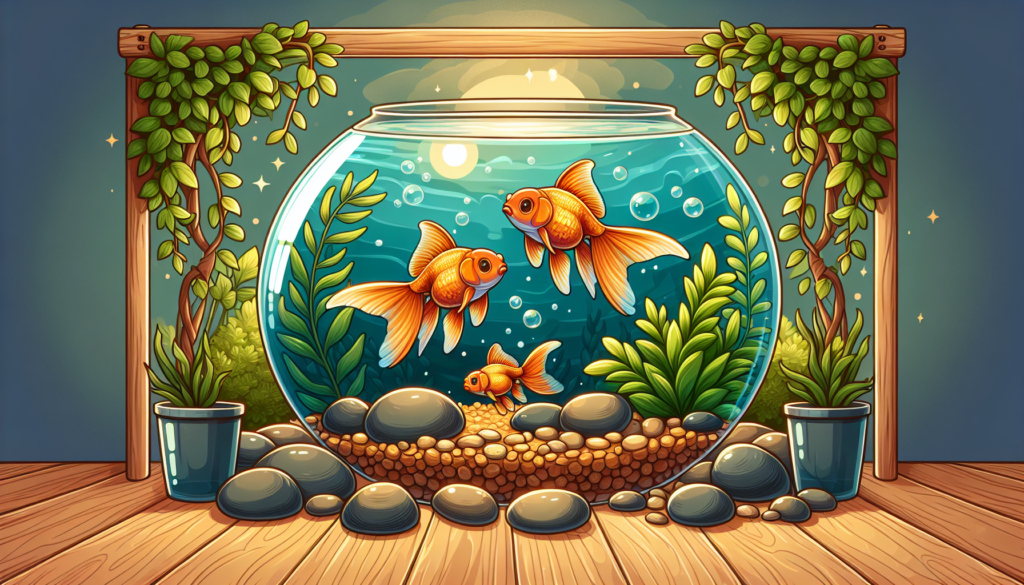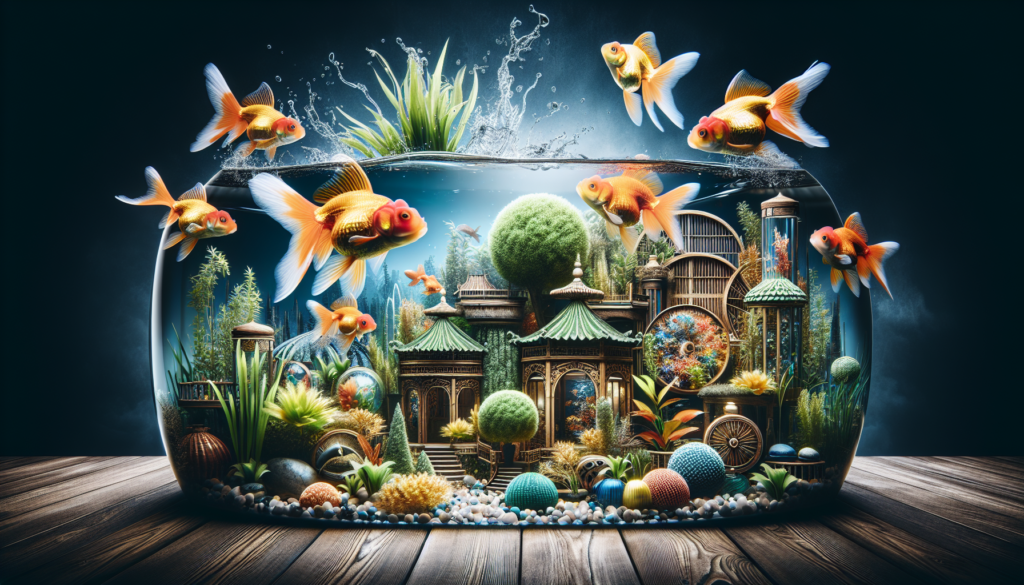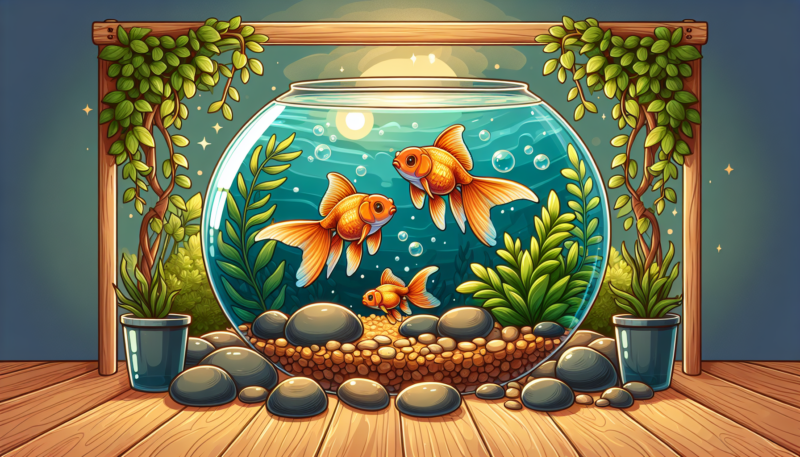Imagine having a beautiful goldfish as a pet, swimming gracefully in its tank, bringing life and beauty to your living space. But do you know how big goldfish can actually get? In this comprehensive guide, we will explore the various factors that determine the size of goldfish and provide you with essential tips and tricks to ensure the optimal growth and care for your beloved aquatic friend. Get ready to dive into the world of goldfish care and discover everything you need to know about helping your goldfish reach its full potential in size and vitality.

Housing and Environment
Tank Size
When it comes to housing your goldfish, it is essential to provide them with the appropriate tank size. Goldfish can grow quite large, with some species reaching up to 12 inches in length. Therefore, it is recommended to start with a tank that can accommodate their potential growth. A general guideline is to provide a minimum of 20 gallons of water per goldfish. Larger tanks are even better as they allow for better swimming space and water quality.
Filtration
A reliable filtration system is crucial for maintaining a healthy environment for your goldfish. Goldfish produce a considerable amount of waste, which can quickly accumulate in the water and lead to poor water quality. A quality filter helps remove debris, uneaten food, and harmful toxins, such as ammonia and nitrites. Look for a filter that is specifically designed for the tank size and capable of handling the goldfish’s waste load.
Temperature
Goldfish are coldwater fish and prefer a water temperature between 65°F and 75°F (18°C to 24°C). It is important to provide a stable temperature within this range, as extreme temperature fluctuations can stress and even harm your goldfish. Monitor the water temperature regularly using a reliable aquarium thermometer and adjust if necessary. Avoid placing the tank near drafty windows or heaters that could impact the water temperature.
Lighting
While goldfish do not require intense lighting like some tropical fish, providing them with a proper light source is still important. A regular day-night cycle helps regulate their biological rhythms and overall well-being. Aim for 10-12 hours of light during the day and ensure the tank is not exposed to direct sunlight, which can lead to excessive algae growth and temperature fluctuations. Use aquarium-specific LED lights for optimal lighting conditions.
Decorations
Goldfish benefit from a well-decorated aquarium that mimics their natural habitat and provides them with mental stimulation. Live or artificial plants, rocks, and driftwood can offer hiding spots and areas for exploration. However, it is essential to choose decorations that won’t harm your goldfish or have rough edges that could cause injury. Avoid using sharp or toxic objects, and regularly inspect the decorations for any signs of wear or damage.
Feeding and Nutrition
Types of Food
Feeding your goldfish a nutritious and balanced diet is key to their overall health and vibrant colors. Goldfish are omnivores, meaning they eat both plant and animal matter. High-quality goldfish pellets or flakes should form the basis of their diet, as they contain essential nutrients. Supplement their diet with fresh or blanched vegetables such as peas, lettuce, or spinach. You can also offer them small amounts of live or frozen foods like bloodworms or brine shrimp for added variety.
Feeding Schedule
Establishing a consistent feeding schedule helps maintain a healthy digestive system for your goldfish. Feed them small portions two to three times a day, only providing what they can consume in a few minutes. Overfeeding can lead to digestive issues and water quality problems. It is important to remove any uneaten food after feeding to prevent it from decomposing and polluting the water.
Portion Control
When it comes to feeding your goldfish, it is crucial to practice portion control. Overfeeding is a common mistake made by goldfish owners. Remember, their stomachs are only the size of their eye, so small and frequent meals are more suitable for them. Adjust the portion size according to the age and size of your goldfish. Monitoring their weight and adjusting the amount of food accordingly can help prevent obesity and related health issues.
Avoiding Overfeeding
Goldfish have insatiable appetites and may appear hungry all the time. However, it is important not to give in to their constant begging. Overfeeding can lead to serious health problems, such as swim bladder disorder and organ damage. Be mindful of the amount of food you’re providing and resist the temptation to feed them more than necessary. Always remember that proper nutrition, not excessive feeding, is the key to their well-being.
Water Quality
Importance of Clean Water
Maintaining clean water is fundamental to the health and longevity of your goldfish. Since they produce a considerable amount of waste, it is crucial to regularly monitor and maintain water quality parameters. Poor water quality can result in stress, weakened immune systems, and an increased susceptibility to diseases. Clean water also ensures the optimal functioning of their respiratory system and overall well-being.
Monitoring Ammonia and Nitrate Levels
Ammonia and nitrate are byproducts of fish waste and decomposition, and their accumulation can be harmful to goldfish. Test the water regularly using reliable aquarium test kits to monitor these levels. Ideally, ammonia and nitrate should be kept at zero, or at the very least, as low as possible. High levels of these toxins can cause stress, respiratory issues, and even death. If levels become elevated, take appropriate actions such as partial water changes and improving filtration.
Water pH and Hardness
Goldfish can tolerate a wide range of pH and water hardness levels. The ideal pH range for goldfish is between 7.0 and 8.4, while the water hardness should be kept between 5 and 20 dGH. Sudden fluctuations in pH or water hardness can stress your goldfish, so it is important to maintain stability. Regularly test these parameters and make any necessary adjustments gradually using pH buffers or water conditioners specifically formulated for goldfish.
Regular Water Changes
Regular water changes are essential for maintaining good water quality and keeping your goldfish healthy. Typically, a 20% to 30% water change should be performed weekly. This involves siphoning out a portion of the old water and replacing it with fresh, dechlorinated water. Be cautious not to disturb the fish or the beneficial bacteria living in the filter media while performing the water change.
Using Water Conditioner
Tap water often contains harmful chemicals such as chlorine and chloramines, which can be detrimental to goldfish. Before adding tap water to the tank, treat it with a water conditioner to remove these harmful substances. Water conditioners also neutralize heavy metals that may be present in the water, making it safe for your goldfish. Follow the instructions on the conditioner bottle to ensure accurate dosing.
Health and Disease
Common Goldfish Diseases
Goldfish can be susceptible to various diseases, some of which are commonly found in aquariums. Common goldfish diseases include swim bladder disorder, fin rot, ichthyophthiriasis (commonly known as ich), and fungal infections. These conditions can be caused by poor water quality, stress, or the introduction of sick fish. It is important to closely observe your goldfish for any signs of illness and promptly address any health concerns.
Symptoms to Watch For
Knowing the signs of illness can help you identify and treat diseases early, improving the chances of a successful recovery. Some common symptoms to watch for include lethargy, loss of appetite, abnormal swimming patterns, visible lesions or spots, fin deterioration, and rapid breathing. If you notice any of these symptoms, it is important to take immediate action and seek appropriate medical advice or treatment.
Quarantine Tank
Setting up a quarantine tank is a proactive measure to prevent the spread of diseases and maintain the overall health of your goldfish. When introducing new fish or plants into your aquarium, they should be quarantined in a separate tank for a few weeks. This helps in observing and treating any potential diseases or parasites before they can infect the main tank. The quarantine tank should replicate the main tank’s conditions but on a smaller scale.
Proper Medication and Treatment
If your goldfish becomes sick, it is crucial to seek appropriate medical advice and treatment. Not all medications are safe for goldfish, so it is important to consult with a veterinarian experienced in fish health or a knowledgeable aquatic specialist. Follow the recommended dosage and treatment duration accurately, and be diligent in monitoring the fish’s progress. Proper treatment can help your goldfish recover and prevent the spread of diseases.

Tank Maintenance
Cleaning Schedule
Regular tank maintenance is necessary to keep your goldfish’s habitat clean and healthy. Establish a cleaning schedule that includes various tasks such as partial water changes, filter maintenance, and substrate vacuuming. Depending on the size of the tank, a thorough clean every 2 to 4 weeks is recommended. Consistency is key, as neglecting regular cleaning can result in poor water quality and potential health issues for your goldfish.
Vacuuming Substrate
Goldfish are known for their love of digging in the substrate, which can lead to a buildup of waste and uneaten food. Regular vacuuming of the substrate helps remove these debris and prevents them from decomposing and polluting the water. Using a gravel vacuum or siphon, carefully clean the substrate while avoiding excessive disruption to the goldfish and the tank’s beneficial bacteria.
Algae Control
Algae growth is a common issue in goldfish tanks due to their high nutrient requirements. While some algae growth is normal and even beneficial, excessive algae can be unsightly and disrupt the balance of the tank. Regularly scrub the tank walls, decorations, and any surfaces that have algae growth. Ensure that you are using algae scrapers or brushes specifically designed for aquarium use, as rough or sharp tools can scratch the glass or harm your goldfish.
Maintaining Equipment
Proper maintenance of your aquarium equipment ensures its optimal functioning and longevity. Regularly inspect the filter, heater, air pump, and any other equipment to ensure they are clean and in good working condition. Replace any worn-out or malfunctioning parts promptly. It is important to follow the manufacturer’s instructions for maintenance and cleaning, as different equipment may require specific care.
Behavior and Socializing
Understanding Goldfish Behavior
To provide the best care for your goldfish, it is essential to understand their natural behavior. Goldfish are social creatures that thrive in the company of their own kind. They are curious and active, constantly exploring their environment. Pay attention to their swimming patterns, feeding habits, and interaction with tankmates. By observing and understanding their behavior, you can identify any potential issues or stressors and make appropriate adjustments to their environment.
Creating an Enriching Environment
Goldfish benefit from an enriched environment that stimulates their natural behaviors. Provide them with plenty of swimming space, hiding spots, and areas to explore. Live plants not only enhance the tank’s aesthetics but also provide oxygen and natural grazing opportunities. Introduce floating objects or mirrors occasionally to prevent boredom and encourage natural behaviors. Changing the tank’s layout periodically can also provide mental stimulation for your goldfish.
Introducing New Tankmates
Goldfish can be kept with a variety of other species, but it is important to choose compatible tankmates to ensure harmony in the aquarium. Avoid keeping goldfish with species that may nip at their fins, such as some tropical fish. Similarly, avoid long-finned goldfish varieties with fish that may mistake their flowing fins for food. Introduce new tankmates gradually, monitoring their interactions closely. If any signs of aggression or stress occur, reevaluate the compatibility and make necessary adjustments.
Breeding and Reproduction
Sexing Your Goldfish
Determining the sex of goldfish can be challenging, especially when they are young or of similar size. However, there are some visual cues that can help in sexing them. Male goldfish generally have small white dots, known as breeding tubercles, on their gill covers and pectoral fins during the breeding season. Females, on the other hand, tend to have a rounder body shape and a larger abdominal region. Observing their behavior during breeding season can also provide indications of their sex.
Setting Up a Breeding Aquarium
Breeding goldfish requires proper preparation and a separate breeding aquarium. The breeding tank should be equipped with a spawning mop or other suitable surfaces for the goldfish to lay their eggs. Provide a gentle filtration system to maintain water quality, but ensure that the filter intake is covered to prevent the eggs from being sucked in. The water temperature should be gradually increased to around 68°F to 74°F (20°C to 23°C) to stimulate breeding behavior.
Spawning Process
The spawning process in goldfish typically involves the male chasing the female, nudging her abdomen to induce egg release, and then fertilizing the eggs externally. Once spawning is complete, remove the adult goldfish from the breeding tank to protect the eggs from being consumed. The eggs will hatch within a few days, and the fry will become free-swimming after a week. Proper care and feeding are crucial at this stage to ensure the fry’s survival.
Caring for Eggs and Fry
After the eggs have been laid, it is important to maintain optimal water conditions in the breeding tank. Ensure that the water quality parameters are suitable, and gently aerate the water to provide oxygen to the developing eggs. As the fry hatch, feeding them infusoria or specialized fry food is essential for their growth and development. Gradually introduce larger food particles as they grow, carefully monitoring their growth and making necessary adjustments to their diet.
Handling and Transportation
Proper Handling Techniques
When it comes to handling goldfish, it is important to be gentle and cautious. Goldfish have delicate scales and fins that can easily be damaged. Wet your hands with aquarium water before handling them to minimize any potential harm. Use a fish net or a cup to catch and transfer the goldfish, avoiding any sudden movements or excessive force. Handle them with care and avoid touching their sensitive gills or eyes.
Preparing for Transportation
Transporting goldfish requires careful preparation to ensure their safety and well-being. Ensure the tank is securely covered and that all equipment, decorations, and accessories are properly secured. Partially fill the transport container with aquarium water, leaving enough space for oxygen exchange. It is recommended to place the goldfish in a plastic bag specifically designed for transporting fish, filled with oxygen and adequately sealed to prevent leakage.
Traveling with Goldfish
During travel, it is crucial to minimize stress and provide a stable environment for your goldfish. Place the transport container in a dark, insulated bag or container to maintain a consistent temperature. Avoid exposing them to direct sunlight or extreme temperatures. Keep the travel duration as short as possible and avoid any sudden movements or vibrations. Upon reaching the destination, acclimatize the goldfish slowly to their new tank by gradually adding tank water to the transport container before releasing them.
Common Mistakes to Avoid
Overstocking the Tank
One of the most common mistakes made by goldfish owners is overstocking the tank. Goldfish produce a significant amount of waste, and overcrowding can lead to high ammonia and nitrate levels, poor water quality, and health issues. Ensure that you provide enough swimming space and consider the adult size of the goldfish when determining the appropriate tank size. Stick to the general guideline of 20 gallons of water per goldfish as a minimum.
Inadequate Filtration
Insufficient filtration is another mistake that can lead to poor water quality and harm your goldfish. Goldfish require a robust filtration system capable of handling their waste load. Choose a filter that is appropriately sized for your tank and consider investing in additional filtration, such as a sponge filter or a protein skimmer, if needed. Regularly clean and maintain the filter media to prevent clogging and ensure its effective functioning.
Poor Water Quality Management
Neglecting water quality management is a grave mistake that can have serious consequences for your goldfish. Regularly test and monitor water parameters such as ammonia, nitrate, pH, and hardness. Perform regular water changes and ensure that the water is properly conditioned and dechlorinated before adding it to the tank. Poor water quality can compromise the immune system of your goldfish, making them more susceptible to diseases.
Feeding Malpractices
Overfeeding or providing inappropriate food can have detrimental effects on your goldfish’s health. Be mindful of portion control and feed your goldfish small meals two to three times a day. Avoid giving in to their constant begging for food, as it can lead to obesity and related health issues. Provide a balanced diet of high-quality pellets or flakes, supplemented with fresh or blanched vegetables and occasional live or frozen foods.
Fun Facts and Trivia
Goldfish Lifespan
Goldfish have an average lifespan of 10 to 15 years, although some well-cared-for goldfish can live up to 20 years or more. Proper nutrition, suitable tank conditions, and attentive care play significant roles in determining their longevity. By providing a healthy environment and meeting their needs, you can help your goldfish live a long and happy life.
Color Variations
Goldfish are known for their stunning and vibrant colors, which can vary greatly. Common color variations include orange (the classic goldfish color), red, white, silver, black, and even calico patterns. Certain goldfish varieties, such as the Ryukin and Fantail, come in a wide range of colors and shapes. The diversity in goldfish colors makes them highly sought after and enjoyable to observe in an aquarium.
Goldfish Myths and Legends
Goldfish have captivated people’s imagination for centuries, leading to numerous myths and legends. One popular myth is the belief that goldfish have a memory span of only a few seconds. However, scientific research debunks this myth, showing that goldfish can retain memories for months and can even be trained to perform tricks. Goldfish are also associated with good luck and prosperity in many cultures, making them a popular choice as pets around the world.
